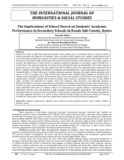| dc.description.abstract | Schools are called to effectively assess and monitor school climate given its potential ability to enhance positive student outcomes and mitigate risk behaviors. When a positive school climate exists, students, staff members and parents feel safe, included and accepted. The school community demonstrates respect, fairness and kindness in their interactions and builds healthy relationships that are free from discrimination and harassment. This study sought to examine the Implications of school unrest on students' academic performance in secondary schools in Bondo sub-County Kenya. The study was guided by the System Theory of biologist Ludwig Von Bertalanffy. A descriptive research design was used in this study. The study adopted the mixed method of study. This study population comprised 3159 Form 3 students, 49 principals, 49 teachers of Guidance and Counseling and 1 sub-county Quality Assurance and Standards Officer in Bondo sub-county.Stratified sampling, purposive sampling and simple random sampling were used to arrive at a sample size of 300 of Form three students from sampled schools. Besides, all Principals and Guidance and Counseling Teachers of the selected schools were also brought on board. Data were collected using a questionnaire, interview schedule and document analysis. After collection, quantitative data were sorted, edited, coded, classified and tabulated for analysis. Data were analyzed using descriptive and inferential statistics. Descriptive statistics results were presented as counts/tables, percentages, bar graphs, column graphs and pie charts. Further, chi-square tests and Spearman correlation tests were run between school climate and students' unrest. This study established that unrest in secondary schools is a consequence of a negative climate, necessitating students' indiscipline and that it has the potential to affect students' overall academic performance. HO2 stated that the association between unrest in schools and students' overall academic performance factor was statistically significant. The study suggested that there is a need to increase students' feeling of safety at school, for example, by reducing victimization, improving overall school and neighborhood safety and promoting classroom engagement. | en_US |

